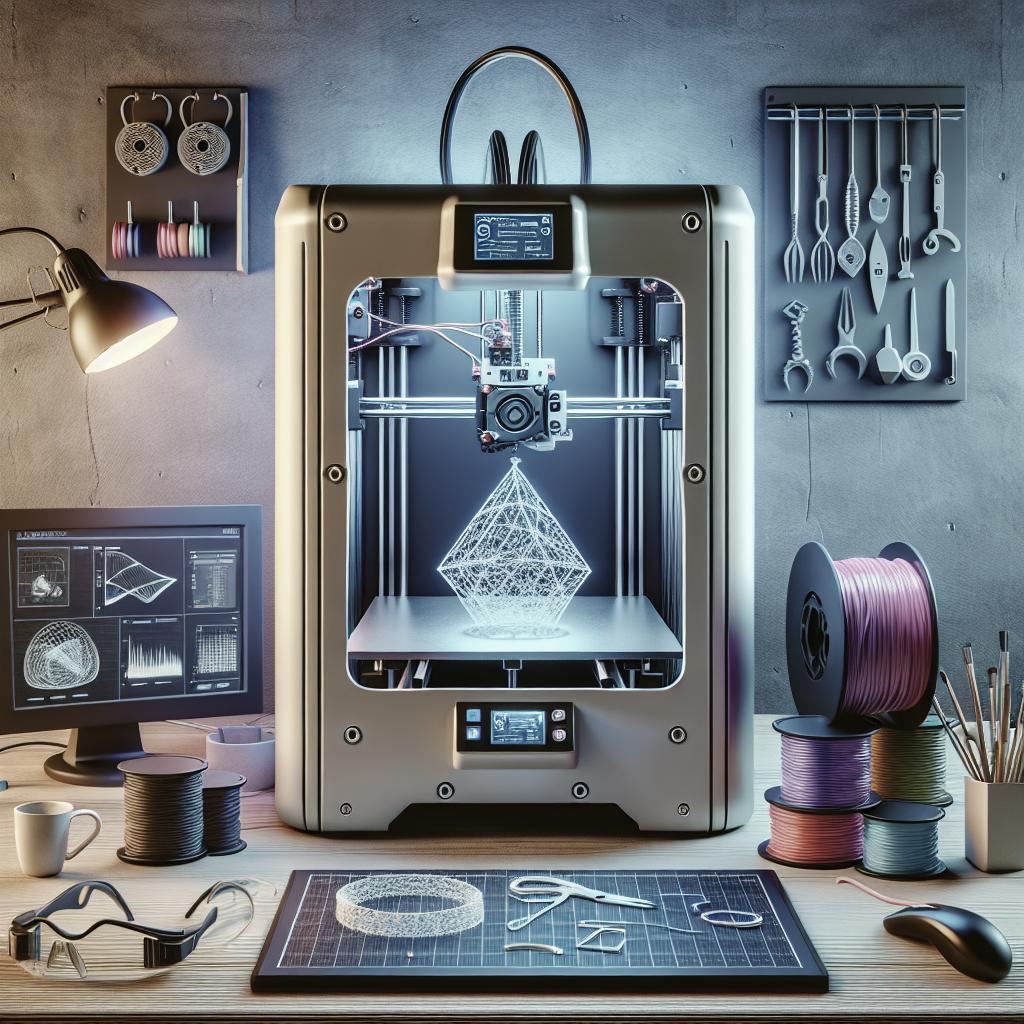“`html
Introduction: 3D Printing Basics
In recent years, the evolution of 3D printing has revolutionized how industries and individuals approach manufacturing, design, and technology. From creating simple tools to realizing complex engineering models, 3D printing has democratized the process of making, enabling anyone with a 3D printer to bring their ideas to life. In this comprehensive guide, we will walk you through the essentials of 3D printing, exploring its basic concepts, key technologies, and providing detailed steps to help you explore its potential. Whether you’re an entrepreneur looking to prototype your latest innovation or a hobbyist yearning to explore new creative outlets, this article is designed to provide you with valuable insights into navigating the exciting world of 3D printing.
Step 1: What Is 3D Printing?
3D printing, also known as additive manufacturing, is a process that transforms digital design files into physical objects by layering materials. Unlike traditional manufacturing methods, which often require subtractive techniques, 3D printing builds objects layer by layer, allowing for greater flexibility and less material waste.
The technology is increasingly utilized across various industries, including aerospace, automotive, healthcare, and education. Its appeal lies in its ability to rapidly prototype models, enabling quick testing and modifications, ultimately facilitating innovation processes.
Step 2: Rapid Prototyping
Rapid prototyping is one of the most significant advantages of 3D printing. It refers to the quick fabrication of a model or a part using 3D computer-aided design (CAD) data. Engineers and designers can create physical prototypes rapidly, test them for form, fit, and function, and iterate based on feedback.
This ability to prototype efficiently accelerates the design cycle, reduces costs, and enhances the precision of the final product. As a result, companies can bring products to market faster and with more refined features that cater to user needs.
Step 3: Intricate Geometries
3D printing allows for the creation of intricate geometries that are challenging to produce with traditional methods. Complex features such as internal pathways, honeycomb structures, and organic shapes can be fabricated with ease, opening up new possibilities in design and functionality.
Such capabilities are particularly beneficial in fields like aerospace and medical devices, where lightweight yet strong components are required. By utilizing 3D printing, designers have greater freedom to explore non-traditional shapes that optimize performance.
Step 4: Customized Content
Customization is another compelling aspect of 3D printing. It enables the fabrication of personalized items or components tailored to specific needs or preferences, whether it’s custom-fitted medical implants, personalized gadgets, or bespoke jewelry.
This level of customization empowers individuals and businesses to create unique products that cater to niche markets, enhancing customer satisfaction and engagement.
Step 5: How Does 3D Printing Work?
The 3D printing process begins with creating a digital model using computer-aided design (CAD) software. This model is then converted into a format that the printer can understand, typically a .STL file. The chosen 3D printer interprets this file and begins constructing the object layer by layer.
The material used for printing depends on the printer type, ranging from thermoplastics and resins to metals and ceramics. Once the object is printed, post-processing steps like cleaning, curing, or assembly may be needed to refine the final product.
Step 6: Fused Deposition Modeling (FDM)
FDM is a popular 3D printing method where thermoplastic filament is heated and extruded through a nozzle to build an object layer by layer. It is widely used for both professional and hobbyist applications due to its cost-effectiveness and simplicity.
FDM printers are available in various sizes and can print an array of materials, including PLA and ABS plastics. Despite some limitations in printing resolution, FDM remains a robust choice for creating functional prototypes and mechanical parts.
Step 7: Stereolithography (SLA)
SLA is a 3D printing technique that uses a laser to cure liquid resin into hardened plastic in a layer-by-layer fashion. Known for producing high-resolution prints, SLA is favored for applications that require precise detail and smooth surfaces.
SLA is widely used in industries that need fine details, such as jewelry and dental labs. While it offers exceptional detail, SLA printing often involves more complex post-processing, including washing and curing the prints.
Step 8: Selective Laser Sintering (SLS)
SLS employs a laser to sinter powdered material, fusing the particles together to create a solid structure. It’s known for its ability to produce strong and durable parts without the need for additional supports.
This method is ideal for creating complex, robust prototypes and functional end-use parts. SLS is predominantly used in industrial applications, offering the benefit of multi-component assembly in a single print run.
Step 9: Laminated Object Manufacturing (LOM)
LOM involves layering and bonding thin sheets of material, cutting them to the desired shape to form each layer. This technique is less common but can be cost-effective for certain applications, allowing for the use of paper, plastic, or composite sheets.
LOM is advantageous for producing large models quickly, although it may sacrifice some detail and surface quality compared to other techniques. It’s mainly explored in contexts where the focus is on speed and material efficiency.
Step 10: 3D Design for 3D Printing
Designing for 3D printing involves creating models that accommodate the limitations and strengths of 3D printers. Software like TinkerCAD, Fusion 360, and Blender provides tools to create detailed models tailored for 3D printing processes.
Considerations include ensuring that parts are printable within your machine’s size constraints and minimizing overhangs that may necessitate support structures. High-quality 3D design not only improves the final print output but also enhances the efficiency of the printing process.
Step 11: Part Orientation
Part orientation is crucial in 3D printing as it influences the strength, surface finish, and printing time of a part. The orientation must be carefully selected based on the intended use and the printer technology employed.
For FDM printers, orienting parts to minimize support and reduce build time can optimize efficiency. In contrast, SLA printing often considers resin flow and surface quality to determine part alignment.
Step 12: Overhangs and Arches
Understanding how 3D printers handle overhangs is essential for creating successful prints. Overhangs are parts of the model that extend outwards and require extra support structures during the printing process.
Designing with self-supporting angles or incorporating arches can mitigate the need for additional support. Engineered solutions like these enhance both the appearance and structural integrity of printed parts.
Step 13: Interfacing With Other Parts
Designing parts meant to interact with others requires precision and attention to detail to ensure proper assembly and functionality. Tolerances should be considered in 3D designs to accommodate the accuracy limitations of the printer and material.
Employing design features such as snap-fits, threaded connections, and joints can enhance the versatility and usability of multi-part assemblies. Testing iterations through rapid prototyping can ensure fit and function prior to final production.
Step 14: Related Technologies
As the field of 3D printing grows, so too does the ecosystem of associated technologies. Techniques like 3D scanning and computer-aided engineering (CAE) play vital roles in the design and refinement stages, complementing 3D printing processes.
3D scanning enables the digitization of physical objects, creating accurate models for replication or modification. Similarly, CAE tools assist in simulating physical phenomena affecting the object, allowing for improvements prior to printing.
Step 15: Resources
To aid in your 3D printing journey, countless resources are available online. Websites such as Thingiverse and MyMiniFactory offer a vast range of designs that you can freely download and print.
Learning platforms like Coursera and Udemy provide educational content to enhance your understanding of 3D printing technologies, while communities and forums present opportunities to share knowledge and troubleshoot with fellow enthusiasts.
Final Thoughts
| Step | Key Point | Details |
|---|---|---|
| 1 | What Is 3D Printing? | Introduction to the concept of additive manufacturing. |
| 2 | Rapid Prototyping | Quickly creating and iterating models for testing. |
| 3 | Intricate Geometries | Creating complex shapes for improved design possibilities. |
| 4 | Customized Content | Enabling personalized and bespoke fabrication. |
| 5 | How Does 3D Printing Work? | Process overview from design to final product. |
| 6 | Fused Deposition Modeling (FDM) | Utilizes thermoplastic filament for cost-effective printing. |
| 7 | Stereolithography (SLA) | Uses a laser to cure liquid resin for high-resolution prints. |
| 8 | Selective Laser Sintering (SLS) | Laser sinters powder to create strong and durable parts. |
| 9 | Laminated Object Manufacturing (LOM) | Layers sheets of material cut to shape, offering speed and efficiency. |
| 10 | 3D Design for 3D Printing | Crafting designs centered around printing capabilities. |
| 11 | Part Orientation | Optimizing orientation for efficiency and quality. |
| 12 | Overhangs and Arches | Managing print challenges for improved structural outcomes. |
| 13 | Interfacing With Other Parts | Ensures accurate assembly and interaction in multi-part projects. |
| 14 | Related Technologies | Integration with 3D scanning and CAE for optimized design. |
| 15 | Resources | Guides and platforms for further learning and design exploration. |
“`


